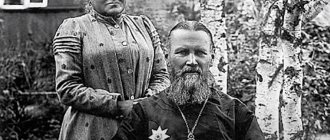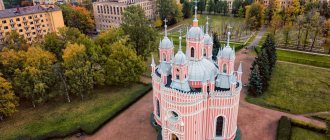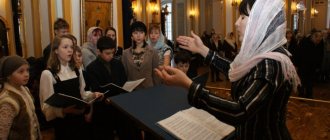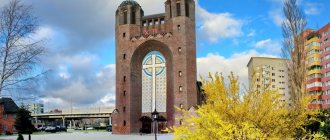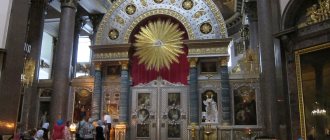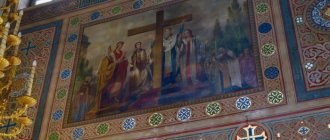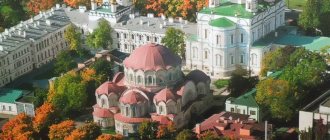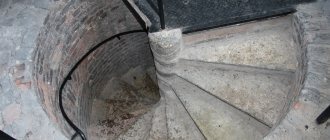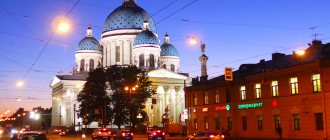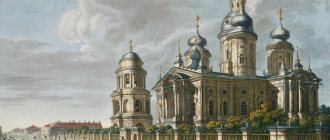History of the temple
The intention to build a temple arose in the 90s. last century. The initiative belonged to Natalia Alexandrovna Lukina. She presented a plan for the restoration of St. Andrew's Cathedral, which was destroyed in 1932.
However, large-scale construction work could not be carried out because financial resources were insufficient. After considering various options, the community decided to build a small church.
Before the revolution, the name of John of Kronstadt was known to almost every resident of the capital and its environs. He was born in 1829 and came from a very poor family. His parents instilled in him the love of God. They were deeply religious people and taught him to attend church regularly from childhood.
Prayers helped the future priest overcome problems at school and become a better student. John also graduated from college, seminary and the St. Petersburg Theological Academy. In a dream he saw that he would be a priest in Kronstadt.
Soon he was offered to marry the daughter of the archpriest of the Kronstadt St. Andrew's Cathedral Church K. Nesvitsky Elizaveta and be ordained a priest in order to serve in the same church.
His sermons were very popular with the parishioners. The fame of the St. Petersburg priest spread throughout the Northern capital, throughout Russia and even beyond its borders, since the rector of St. Andrew's Church not only preached. He also did charity work, helping the poor, disadvantaged and healing people.
After some time, John of Kronstadt discovered the gift of miracles. He healed patients whom medicine could no longer help. People came to him from all cities.
Sometimes the priest helped people in absentia. They sent him a telegram, and he treated the sick with his prayers. He healed the blind, freed those suffering from addiction and failure.
John of Kronstadt confessed to people for several hours a day. The priest led a rather ascetic lifestyle, sleeping only 4 hours a day. His fame led to the fact that merchants and manufacturers began to send him large sums of money. The abbot spent it on building schools and a hospital, and also distributed it to the needy.
The priest died in 1908 from a serious illness. The abbot was buried in the tomb of the Ioannovsky Monastery, located on Karpovka. It was in his honor that the church and the square on which it stands were named.
The building was designed by the famous architect of St. Petersburg Ivan Nikolaevich Knyazev. Construction of the temple began in 1998. The foundation stone for the church was carried out by the archpriest of the Nevsky deanery district, Viktor Golubev, in April of the same year. Construction was completed in 2002.
On December 21, 2004, the same archpriest V. Golubev performed the Sacrament of consecration of the temple. And on September 3 of the same year, Metropolitan Vladimir of St. Petersburg and Ladoga appointed M. Podoley as rector of the built church. From that time on, services began to take place constantly.
Later in 2014, a cathedral church, as well as a spiritual and educational center, began to be built next to the temple. Now there is an Orthodox youth club, a Sunday school, and a library at the complex.
External appearance and interior decoration of the Kronstadt Naval Cathedral
The Naval St. Nicholas Cathedral is a replica of the Constantinople Church of Hagia Sophia, but with slightly reduced and modified proportions. Architect Kosyakov made a special trip to Constantinople to take measurements of Hagia Sophia. The length of the St. Nicholas Naval Cathedral is 83.2 m, width - 64 m, dome diameter - 26.7 m, height to the base of the main dome - 52 m, height from the ground to the highest point of the cross - 75 m. The central part under the dome could accommodate 3000 those praying.
Naval St. Nicholas Cathedral
The huge dome sparkling in the sun and the cross above it are visible from afar, serving as a guide for sailors. This feels like a kind of echo with the never-realized project of Peter I to build a 213-meter lighthouse tower in the center of Kronstadt.
Dome of the Naval St. Nicholas Cathedral
The base of the Naval Cathedral is lined with light granite, the walls are gray-yellow brick and terracotta. Above the entrances there are mosaic inserts created in the workshop of V.A. Frolov: the image of the Mother of God above the northern gate, St. Mitrophania - above the southern one. The western facade is decorated with mosaic panels with images of the Holy Apostles Peter and Paul (left), St. Nicholas the Wonderworker and St. John of Rila (right). In the niche of the main entrance from Anchor Square there is a chapel of the Savior Not Made by Hands.
Western facade of the Naval St. Nicholas Cathedral
The interior decoration of the Naval Cathedral is striking in its luxury. It uses mosaics with a predominance of gold, blue and light gray colors and frescoes. Thanks to the transition from dark granite in the design of the lower tier to gold and sky-blue mosaics under the dome, the effect of the cathedral reaching up to the heavens is achieved. On a clear sunny day, a particularly strong feeling of radiance is created inside the cathedral.
The altar is raised 4 meters. Iconostasis by sculptor N.A. Popov according to the design of V.A. and G.A. Kosyakov is made of natural white and colored Ural marble. It is decorated with mosaic inserts and bronze details. The two-tiered galleries are supported by artificial marble columns. The altar, sails and vaults of the northern and southern choirs are decorated with paintings by the artist M.M. Vasiliev, made to resemble mosaics and frescoes.
The main altar of the Naval Cathedral was consecrated in the name of St. Nicholas the Wonderworker, the right one - in the name of the Holy Apostles Peter and Paul, the left one - in the name of St. John of Rila and in honor of the holy righteous John of Kronstadt.
Interior decoration of the Naval St. Nicholas Cathedral
Interior decoration of the Naval St. Nicholas Cathedral
Side galleries
Interior decoration of the Naval St. Nicholas Cathedral
Second tier gallery
Interior decoration of the Naval St. Nicholas Cathedral, western stained glass window with the image of “Deesis”
Iconostasis of the Naval St. Nicholas Cathedral
Domes of the Naval St. Nicholas Cathedral
The granite mosaic floor in a thin copper frame, with images of various animals, birds and sea monsters, is extremely beautiful.
Mosaic floor
The Naval Cathedral is not only a temple, but also a museum. It contains ship icons, banners, models of ships lost in naval battles and other exhibits dedicated to the glorious history of the Russian fleet.
Model of the Naval St. Nicholas Cathedral
Model of the squadron battleship Borodino, which distinguished itself in the Battle of Tsushima. Died on May 14 (27), 1905, sinking with almost the entire crew (865 people). Only one person survived
But here, perhaps, is the main thing for which you need to go to the Naval St. Nicholas Cathedral in the first place: memorial plaques made of black marble, where the names of the dead sailors are carved in gold letters. The names of the deceased clergy are carved on white marble boards. Here the entire history of the Russian fleet passes before your eyes.
There are 130 boards in total, some of them are empty. The names of future heroes will be entered here. Now about 1,000 names of sailors who died between 1695 and 1910 are carved here and are remembered during their service.
The names of all those killed, not only in battles, but also in the line of duty, officer ranks of the naval department (naval corps, admiralty, civil and medical ranks, clergy and midshipmen) should be written on the memorial plaques in the Cathedral. Religions are indifferent, both Christian and non-Christian. — Russian State Administration of the Navy f.427 op.3 d. 782 l.10. Quote by: Elena Isakova. Kronstadt Naval Cathedral in the Orthodox tradition of patriotic education in the navy.
Memorial plaques dedicated to the Defense of Sevastopol 1854-1855
Inscription dedicated to Admiral Nakhimov
There are also inscriptions dedicated to campaigns abroad, for example, the suppression of the Boxer Rebellion in China (1898-1901).
Losses of Russian sailors during the Boxer Rebellion in China
Where is the church in St. Petersburg
The Church of John of Kronstadt in St. Petersburg is located in the Kirovsky district. It is located on the corner where Leninsky Prospekt intersects with Stachek Avenue.
- Postal code: 198207.
- Address: Kronstadt Square, 2.
- Telephone.
Architecture[edit]
The stone cathedral, in general, repeats in plan the technique used in the construction of the Church of Hagia Sophia in Constantinople.
At the same time, the ratio of the parts of the temple is different and the temple is somewhat smaller than the prototype. The diameter of the dome of Hagia Sophia is 31 meters, and the diameter of the dome of the Naval Cathedral is 26.7 m; The height is 56 and 52 meters. [11][12] Lengths of both 81 and 83 meters. The width is both 72 and 64 meters. But the general idea of the planning solution with the support of the central dome on the apses, as well as the layout of the side colonnades in the traditional Byzantine basilica style, as well as the paintings, are certainly within the same Byzantine concept.
The side of the internal central hall is 24 meters; the spans of the main arches are 23 meters. The height to the base of the main dome is 52 meters; the external height with the cross is 70.5 meters. This is the tallest building in Kronstadt.
How to get there
There are different ways to get to the church.
From metro station Prospekt Veteranov
Walk from the metro stop to Dachny Prospekt. At this point they cross the road and then turn left.
Then follow only the avenue to get to Kronstadt Square. Then they turn to the right and find themselves right next to the church.
From the same station there is bus No. 486 or minibus No. 650A. Get off at the Leni Golikova stop. Then you need to walk about another 900 m.
From Leninsky Prospekt metro station
From this metro stop you should walk to Leninsky Prospekt. The highway crosses here. Then they turn to the left. Then they walk along the sidewalk until they get to Kronstadt Square. Then you need to turn right. There will be a church right there.
Various public transport also runs from the station:
- bus No. 26, 87, 142;
- minibus No. 43, 87, 103, 226, 242, 339, 420;
- trolleybus No. 32, 35, 45.
They go out to the square. Then they walk about 100 m.
From metro station "Avtovo"
After leaving the station, you pass Avtovskaya and Kronstadtskaya streets. Then cross Marshall Kazakov Street.
Then they turn left. They go to Stachek Avenue, and then move along it. Having reached Kronstadt Square, you should then cross the roadway to get to the church.
From Avtovskaya station there is also a minibus No. 401A or tram No. 36, 41, 52. The transport stops at Solomakhinsky Proezd. Then they walk 400 m under their own power.
Minibus No. 655 also runs from Stachek Avenue.
Architecture Features
This temple was built in the pseudo-Russian style, which is typical of one of the Art Nouveau styles of the early 20th century. Architectural historian Mikhail Mikishatyev says that A. Shchuseyev, as well as other architects, worked in the same manner.
In St. Petersburg, buildings made in the neo-Russian direction are almost never found. They look alien among the buildings of the Northern capital. However, many architects admitted that the church turned out to be unusually stylish and colorful. It fits perfectly into the surrounding landscape.
Community representatives chose an unusual color for the roof and dome. Instead of the soft blue shade common in the past, they preferred a bright blue paint called “Rublevsky cabbage roll”. Therefore, the architect Knyazev was somewhat worried about this shade, since he did not know how it would look.
But the architect’s fears were in vain, and the parishioners really liked this color. In addition, the entire architectural composition of the temple looks emphatically free and airy. It is distinguished by a modern sharpness, as well as a deliberate increase in the upper part of the building.
In the square in front of the temple, instead of a wooden cross, a stone crucifix was installed. Next to the church there is also a monument to the heroes of the Narva outpost.
Exterior decoration
The church is quite small. It is covered with a blue roof and crowned with a dome of the same color. The building looks very much like a chapel. It is elongated and irregular in shape. The building has white stone walls. The structure looks very organic. It is clearly visible from afar.
The exterior decoration contains many triangles with soft outlines, which gives the building an unusual appearance. The windows have the same shape. They are distinguished by fine devitrification. The building is decorated with overhanging cornices made of wood.
Church of John of Kronstadt in St. Petersburg
There are practically no buildings in this style in St. Petersburg. Therefore, all of the listed features are characteristic specifically of the Church of John of Kronstadt. This is the best religious building, according to Mikishatiev, that he has ever examined.
Interior decoration
Inside the temple, the snow-white walls and sky-hued ceilings are richly painted. There is a large chandelier in the center. The iconostasis in the church is made of wood and decorated with very beautiful carvings. The room is quite bright.
Thanks to the large number of triangular windows, a lot of daylight penetrates inside. However, the small size of the premises often does not allow the church to accommodate everyone at once.
Naval St. Nicholas Cathedral in the Soviet years and today
It is difficult to imagine what tragic fate awaited the Naval St. Nicholas Cathedral during the Soviet years. On June 1, 1929, the last service took place in the Naval Cathedral, after which the temple was closed and looted. The beautiful iconostasis was destroyed. Instead of a cross, it was proposed to install a star or a statue of Lenin on the dome. Thus, the newspaper “Red Baltic Fleet” wrote:
The statue of Ilyich should stand with an outstretched arm towards the sea, as if inviting foreign workers to visit the USSR. — Quote. by: V.Ya.Krestyaninov. Kronstadt. Fortress. City. Port. St. Petersburg, 2014. P.64
In 1932, part of the cathedral’s premises was occupied by the Maxim Gorky club, which was popularly called “Maksimka”, and the other was given over to warehouses. During the Great Patriotic War, an observation and correction post for the naval and coastal artillery of Kronstadt was located under the dome. In the northern part of the cathedral, on the floor there is a trace left from an unexploded German bomb that pierced the dome in 1943.
In the 1950s, a suspended ceiling was built, which separated the auditorium from the dome part. On February 22, 1955, the Kronstadt Fortress club opened in the former Naval Cathedral.
The wind blew through the broken windows and rain poured, and the stars visible on the dome could be confused with real ones. Pigeons settled here for many decades. Only on the cracked wall was the face of a cherub, pale from the weather, visible... - E.V. Isakova, M.V. Shkarovsky. Temples of Kronstadt. St. Petersburg, 2004. pp. 180-182
Club in the former Naval Cathedral of Kronstadt
In 1976, the building of the former cathedral was taken under protection as an architectural monument. In 1978, the Sailors' Club opened here, which existed until 1989. Also, since the 1980s, the Kronstadt Fortress museum has functioned here.
By the early 2000s, the former Naval St. Nicholas Cathedral was a sad sight. Although its owner, the Marine Engineering Service, tried to maintain the safety of the building, there was a catastrophic lack of money for maintenance, especially after the crisis of the 1990s. There were frequent floods on the ground floor caused by the rupture of old, pre-revolutionary pipes.
The question of transferring the temple to the Russian Orthodox Church, but with the preservation of the cathedral as a naval cathedral, was repeatedly raised. However, the Church did not have money for the maintenance and restoration of this unique temple at that time.
Nevertheless, on November 2, 2005, the first Liturgy was served in the Naval St. Nicholas Cathedral. In 2007, it was transferred to the balance of the Central Naval Museum. However, the repair work carried out at that time was fragmentary, and destruction continued. In 2009, after the cracks in the walls and dome increased significantly, the cathedral building was declared unsafe and in need of urgent restoration.
Just like a hundred years ago, the whole world raised funds for the restoration of the Naval Cathedral. Once again, sailors made the largest financial contribution, but donations also came from ordinary citizens and large corporations. The money was accumulated by the international charitable foundation “Kronstadt Naval Cathedral in the name of St. Nicholas the Wonderworker.” A Public Trustee Council was created.
To preserve the building, in 2009 it was dressed in a special protective sarcophagus made of reinforced film. Restoration work proceeded at a rapid pace. Lost details of the interior decoration, mosaics, and stained glass windows were restored using old photographs and drawings. It is especially worth noting the many years of work of Elena Isakova, who painstakingly restored memorial plaques with the names of the dead sailors.
Protective sarcophagus of the Naval Cathedral in Kronstadt (photo from the Internet)
On April 24, 2012, Patriarch Kirill of Moscow and All Rus', in the presence of Russian President D.A. Medvedev, performed the rite of the Minor Consecration of the Cathedral. On May 28, 2013, on the centenary of the consecration of the Naval St. Nicholas Cathedral, Patriarch Theophilus of Jerusalem and Patriarch Kirill of Moscow and All Rus' performed the rite of the Great Consecration and the Divine Liturgy.
Naval Cathedral, southern facade
Nowadays, the Naval Cathedral in Kronstadt performs a double function. It is the main temple of the Russian Navy. He is also stauropegial, that is, directly subordinate to the Patriarch. At the same time, it is a branch of the Central Military History Museum. But, first of all, the Naval St. Nicholas Cathedral is a monument to all sailors who died defending their fatherland - Russia.
[The Naval Cathedral was conceived] as a temple-monument in which an atoning bloodless sacrifice would be offered daily, [and which] would serve at the same time as a connecting link of the past, present and future of the Russian fleet, an eternal witness to the works, knowledge, exploits that served to glory homeland and fleet. — Russian State Administration of the Navy f.427 op.3 d.177. Quote by: Elena Isakova. Kronstadt Naval Cathedral in the Orthodox tradition of patriotic education in the navy.
Mosaic panel “Triumph of the Russian Fleet” near the Naval St. Nicholas Cathedral
As before, a majestic monument to Admiral Makarov stands on Anchor Square. Not far from it is a monument to the fighters for Soviet power, in the form of a pyramid, in the center of which an eternal flame burns. Anchor Square is decorated with a huge anchor with a cross inscribed in it and the silhouette of a temple around it, which resembles an ancient Russian military helmet.
Naval Cathedral in Kronstadt, photo by Nikolai Ivanov, St. Petersburg
Divine services
The church holds services every day:
| Confess | |
| Monday - Saturday | 9:30 – 10:00 |
| Sundays/holidays | 9:00 – 10:00. |
| Liturgy | from 10:00 |
| Monday Friday | from 18:00 |
| weekend | from 17:00 |
| other weekdays | |
| Pastoral hour (regular days) | |
| Friday | 14:00 – 16:00 |
| Sunday | 17:00 |
More detailed information should be obtained by phone or on the website of the temple complex.
Social activity
The Church of John of Kronstadt in St. Petersburg carries out spiritual and social activities in various areas, for example:
- conversations on Orthodox topics;
- catechetical courses;
- working with children and youth.
- Sunday school lessons.
Youth work
The work of the parish with the younger generation is important and necessary. It gives the concept and explains the essence of Holy Scripture. The book talks about different ways of serving the Church.
Such activities have common goals:
- Reading spiritual literature, and then explaining the theological text and the instructions of the holy fathers.
- First, a topic of interest is identified and then discussed.
- A participant or invited guest prepares and conducts meetings.
- Various ceremonial events are organized in the church.
Young people usually gather on Sundays, when the service ends. In the evening, the Akathist is usually read until 17:00. And the youth club starts its work at 18:00.
The schedule is sometimes changed. It depends on the duration of the services.
Sunday School
As you know, an Orthodox school was created at the complex. Boys and girls attend it.
Lessons are held on certain days:
| Saturdays | 11:30 – 13:00 | 5 – 7 years old (junior schoolchildren) |
| 13:00 – 14:30 | 8 – 11 years old (middle group) | |
| Sundays | 12:30 – 14:00 | 12 – 18 years old (teenagers) |
Children whose parents attend the parish are accepted for education. The abbot gives them his blessing. A copy of the enrollment form is taken from the candle box. It is filled out and then sent by email. Or the parents themselves bring the document to the temple.
Catechesis
The Church of John of Kronstadt in St. Petersburg conducts educational activities. It is based on training. It includes catechesis and education. Anyone who has chosen the path of Orthodoxy can attend such classes.
Catechesis is help to a believer who consciously wants to join life in Orthodoxy. The study of religion gives an idea of religion and moral Christian norms. Explains the significance of Holy Scripture and Church Tradition.
Clergymen conduct at least 2 conversations with converts, called catechesis. They talk about the basics of Christianity, give an idea of the Orthodox faith and life in the Church.
Sometimes it is quite difficult for beginners to understand the meaning of the Sacrament. That’s why the first conversation is dedicated to this topic. She is given special attention. They also give an initial idea of Orthodoxy and answer questions.
In the following conversation, general knowledge about Christianity is taught. They tell you how to live in it. Explain the meaning of the Creed. Explain the essence of the main biblical commandments. At the end of the lesson, they check whether the main religious truths have been correctly learned.
People who choose Orthodoxy should know that infants, as well as children under 7 years of age, are baptized according to the faith of their parents and adoptive children. Usually such a Sacrament takes place in a temple. Therefore, the father, mother, and godparents need to undergo minimal training, called catechetical training.
However, they do not need such training if they have an understanding of the basics of faith and are also churchgoers.
Conversations take place according to certain schedules:
With the priest:
| Monday to Thursday | 15:30 – 17:00 |
| Friday Shepherd's Help | 14:00 – 16:00 |
| 16:30 – 17:00 | |
| On Sundays | 15:00 – 16:00 |
With a catechist:
| Tuesday | 15:00 – 17:00 |
| Sunday | 13:00 – 16:00 |
The Church of John of Kronstadt in St. Petersburg takes part in various church-wide and secular events, for example:
- conducts services and religious processions;
- organizes all kinds of concerts, festivals, exhibitions.
Servants of the temple complex provide assistance to various social or educational institutions located in the Krasnoselsky, Kirov, or Petrodvortsovo districts of the Northern capital.
- The church has been cooperating with the Crisis Center for many years. This is a government organization that helps women. Rector M. Podoley has been conducting the Sacrament of Baptism for 13 years in the rehabilitation department called “Little Mother”. It was created for girls who became mothers early, that is, under the age of majority and who found themselves in a difficult life situation.
- The rector conducts conversations on educational topics and visits the shelter on holidays. The wards go to church services. Today, the social institution is building a library on a spiritual theme, and is also building a chapel.
- In Peterhof there is “Boarding House No. 2”. It houses children with mental disabilities. For many years the rector and his assistants have been visiting him. They baptize children, conduct spiritual sermons, organize Easter and Christmas holidays. Sponsors are brought on a special bus to the church to participate in services.
- The parish of the temple complex also helps Children's Home No. 1. It organized the study of the Law of God. Lessons take place in library no. 15.
- Priests hold educational meetings with residents. Conversations take place at the Kirovets Central Children's Palace. Teachers from the Theological Academy are invited to attend.
- The church provides support to the Society for the Disabled, as well as the Social House, located on Zhukov Avenue, 37.
- For many years, the Kirovets Children's Palace has provided an office in which a Sunday school is located. Now there are more than 80 guys involved in it.
- On the Easter holidays, the parish holds a themed celebration for schoolchildren from local areas. It is called "Red Easter". Children and parents are taken on excursions to the temple complex. Master classes on making postcards and various games are organized for them.
The archpriest, being the dean of the Krasnoselsky district of the diocese of St. Petersburg, holds various events in this area:
- January 27 is the Day of lifting the blockade in Leningrad.
- Every year he holds a charity dance evening for secondary and Sunday school students. It is also called the Sretensky Ball.
- Every year it organizes Christmas readings for teachers, children and parents.
- The abbot congratulates local residents on various holidays.
- Reads a prayer of thanks, participates in the procession of the “Immortal Regiment” on May 9 in the village of Dudergof.
- On the day of family, love and fidelity - July 8, he organizes a concert dedicated to Peter and Fevronia.
- The clergy of the temple also constantly takes part in various other patriotic and cultural events.
The Church of John of Kronstadt is a unique modern landmark, as well as the center of spiritual life in the Krasnoselsky and Kirovsky districts in St. Petersburg.
History[edit]
The Naval Cathedral in the fortified city of Kronstadt (with three altars - in the name of St. Nicholas the Wonderworker, St. App. Peter and Paul and St. John of Rylsky) was founded on September 1 (14), 1902 by decree of Emperor Nicholas II in honor of the 200th anniversary of the Russian fleet. A prayer service for the construction of the temple was performed by the holy righteous John of Kronstadt.
The author of the project is Professor V.A. Kosyakov took Hagia Sophia in Constantinople as a model. The commander of the Kronstadt Fort, Vice Admiral N.I., participated in the construction of the cathedral. Kaznakov, Vice Admiral S.O. Makarov and other outstanding Russian naval commanders. Built with public donations and funds from the Naval Department, the cathedral was consecrated on June 10 (23), 1913 in the presence of the imperial family by Protopresbyter Georgy Shavelsky, co-served by Archpriest John Morev and the future martyr Archpriest Alexy Stavrovsky.
Conceived as a monument to all sailors who died for the Fatherland in battle or from wounds, St. Nicholas Church was rightfully considered the spiritual center of the entire Russian fleet. The names of 12 thousand sailors who died for the Fatherland were carved on memorial plaques, for whom prayer was offered daily in the cathedral. Relics associated with the maritime glory of the state were carefully preserved here.
The unique temple-monument to the history of the Russian Navy has become the urban and maritime dominant of Kronstadt - the main dome of the temple is visible from all points of the Nevsky Fairway.
On October 14, 1929, the cathedral was closed and destroyed. The Altar of the Lord was desecrated, the memory of the fallen soldiers was desecrated, crosses and bells were thrown down. During the Great Patriotic War, the temple was shelled. Over the years, the temple housed a cinema, a club, and a concert hall. Through the efforts of military sailors and museum workers, it was possible to preserve only a small part of the magnificent interior decoration, which was not destroyed.
As a result of internal reconstruction, the cathedral was divided vertically into two parts by massive ceilings. The thermal regime in the dome part was disrupted and there was no heating. As a result of improper operation, the cathedral found itself in disrepair, and only the prompt start of restoration work saved the building from inevitable destruction.
